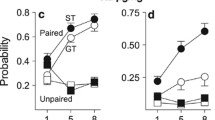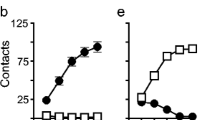Abstract
Rationale
Understanding the behavioral and neurobiological factors that render some individuals more susceptible than others to opioid addiction will be critical in combatting the opioid crisis.
Objective
The purpose of the current study was to determine if behavioral traits associated with an increased likelihood to take and seek cocaine are the same traits that render one more susceptible to opioid-taking and opioid-seeking behavior. Individual differences in the acquisition of remifentanil self-administration and subsequent cue-induced reinstatement of remifentanil-seeking behavior were investigated using two animal models: the high-responder (HR)/low-responder (LR) and sign-tracker (ST)/goal-tracker (GT) models. Relative to LR rats, HR rats show increased novelty-induced locomotion or “sensation-seeking” behavior, and are more likely to acquire cocaine-taking behavior and do so at a faster rate. Relative to GT rats, ST rats attribute greater incentive motivational value to reward cues and are more likely to exhibit reinstatement of cocaine-seeking behavior.
Results
In contrast to previous work using cocaine, we did not observe individual differences with respect to the acquisition of remifentanil self-administration- or cue-induced reinstatement of remifentanil-seeking behavior within the context of either the HR/LR or ST/GT model. Thus, neither the sensation-seeking trait nor the propensity to attribute incentive motivational value to reward cues predicts remifentanil-taking or remifentanil-seeking behavior.
Conclusions
These findings suggest that different traits may confer the initiation of opioid- vs. cocaine-taking behavior, and the propensity to relapse to opioid- vs. cocaine-seeking. Additional studies are needed to identify which neurobehavioral constructs confer liability to opioid use and relapse.





Similar content being viewed by others
References
Ahrens AM, Singer BF, Fitzpatrick CJ, Morrow JD, Robinson TE (2016) Rats that sign-track are resistant to Pavlovian but not instrumental extinction. Behav Brain Res 296:418–430
Algallal H, Allain F, Ndiaye NA, Samaha AN (2020) Sex differences in cocaine self-administration behavior under long access versus intermittent access conditions. Addict Biol 25:e12809
Ambrosio E, Goldberg SR, Elmer GI (1995) Behavior genetic investigation of the relationship between spontaneous locomotor activity and the acquisition of morphine self-administration behavior. Behav Pharmacol 6:229–237
Belin D, Mar AC, Dalley JW, Robbins TW, Everitt BJ (2008) High impulsivity predicts the switch to compulsive cocaine-taking. Science 320:1352–1355
Berridge KC (2004) Motivation concepts in behavioral neuroscience. Physiol Behav 81:179–209
Bertz JW, Jackson EL, Barron DR, Woods JH (2016) Effects of sex and remifentanil dose on rats’ acquisition of responding for a remifentanil-conditioned reinforcer. Behav Pharmacol 27:137–147
Boakes R (1977) Performance on learning to associate a stimulus with positive reinforcement. In: Davis H, Hurwitz H (eds) Operant-Pavlovian interactions. Lawrence Erlbaum Associates, Hillsdale, NJ, pp 67–97
Boggiano MM, Cavigelli SA, Dorsey JR, Kelley CEP, Ragan CM, Chandler-Laney PC (2008) Effect of a cage divider permitting social stimuli on stress and food intake in rats. Physiol Behav 95:222–228
Caprioli D, Celentano M, Dubla A, Lucantonio F, Nencini P, Badiani A (2009) Ambience and drug choice: cocaine- and heroin- taking as a function of environmental context in humans and rats. Biol Psychiatry 65:893–899
Crespo JA, Sturm K, Saria A, Zernig G (2005) Simultaneous intra-accumbens remifentanil and dopamine kinetics suggest that neither determines within-session operant responding. Psychopharmacology 183:201–209
Cummings JA, Gowl BA, Westenbroek C, Clinton SM, Akil H, Becker JB (2011) Effects of a selectively bred novelty-seeking phenotype on the motivation to take cocaine in male and female rats. Biol Sex Differ. https://doi.org/10.1186/2042-6410-2-3
Davis BA, Clinton SM, Akil H, Becker JB (2008) The effects of novelty-seeking phenotypes and sex differences on acquisition of cocaine self-administration in selectively bred High-Responder and Low-Responder rats. Pharmacol Biochem Behav 90:331–338
De Luca MT, Montanari C, Meringolo M, Contu L, Celentano M, Badiani A (2019) Heroin versus cocaine: opposite choice as a function of context but not of drug history in the rat. Psychopharmacology 236:787–798
Deroche-Gamonet V, Belin D, Piazza PV (2004) Evidence for addiction-like behavior in the rat. Science 305(5686):1014–7
Ferris MJ, Calipari ES, Melchior JR, Roberts DCS, España RA, Jones SR (2013) Paradoxical tolerance to cocaine after initial supersensitivity in drug-use-prone animals. Eur J Neurosci 38:2628–2636
Fitzpatrick CJ, Gopalakrishnan S, Cogan ES, Yager LM, Meyer PJ, Lovic V, Saunders BT, Parker CC, Gonzales NM, Aryee E, Flagel SB, Palmer AA, Robinson TE, Morrow JD (2013) Variation in the form of Pavlovian conditioned approach behavior among outbred male Sprague-Dawley rats from different vendors and colonies: sign-tracking vs. goal-tracking. PLoS One 8:e75042
Flagel SB, Robinson TE (2017) Neurobiological basis of individual variation in stimulus-reward learning. Curr Opin Behav Sci 13:178–185
Flagel SB, Robinson TE, Sarter M (2021) Comment on Pohorala et al: Sign-tracking as a predictor of addiction vulnerability. Psychopharmacology 238(9):2661–2664
Flagel SB, Chaudhury S, Waselus M, Kelly R, Sewani S, Clinton SM, Thompson RC, Watson SJ Jr, Akil H (2016) Genetic background and epigenetic modifications in the core of the nucleus accumbens predict addiction-like behavior in a rat model. PNAS 113:E2861–E2870
Florence CS, Zhou C, Luo F, Xu L (2016) The economic burden of prescription opioid overdose, abuse, and dependence in the United States, 2013. Med Care 54:901–906
Freeman KB, Woolverton WL (2011) Self-administration of cocaine and remifentanil by monkeys: choice between single drugs and mixtures. Psychopharmacology 215:281–290
Grimm JW, Hope BT, Wise RA, Shaham Y (2001) Neuroadaptation. Incubation of cocaine craving after withdrawal. Nature 412:141–142
Hearst E, Jenkins H (1974) Sign-tracking: the stimulus-reinforcer relation and directed action. Monograph of the Psychonomic Society, Austin
Kabbaj M, Devine DP, Savage VR, Akil H (2000) Neurobiological correlates of individual differences in novelty-seeking behavior in the rat: differential expression of stress-related molecules. J Neurosci 20:6983–6988
Kawa AB, Robinson TE (2019) Sex differences in incentive-sensitization produced by intermittent access cocaine self-administration. Psychopharmacology 236:625–639
Kerstetter KA, Aguilar VR, Parrish AB, Kippin TE (2008) Protracted time-dependent increases in cocaine-seeking behavior during cocaine withdrawal in female relative to male rats. Psychopharmacology 198:63–75
Kippin TE, Fuchs RA, Mehta RH, Case JM, Parker MP, Bimonte-Nelson HA, See RE (2005) Potentiation of cocaine-primed reinstatement of drug seeking in female rats during estrus. Psychopharmacology 182:245–252
Koffarnus MN, Hall A, Winger G (2012) Individual differences in rhesus monkeys’ demand for drugs of abuse. Addict Biol 17:887–896
Krueger LD, Chang SE, Motoc M, Chojecki M, Freeman ZT, Flagel SB (in press) Impact of social housing on long-term patency of jugular catheters in rats (Rattus norvegicus). J Am Assoc Lab Anim Sci. https://doi.org/10.30802/AALAS-JAALAS-20-000071
Kuhn BN, Campus P, Klumpner MS, Chang SE, Iglesias AG, Solberg Woods L, Flagel SB (2021) Inhibition of a cortico-thalamic circuit attenuates cue-induced reinstatement of drug-seeking behavior in “relapse prone” rats. Psychopharmacology. https://doi.org/10.1007/s00213-021-05894-9
Kuhn BN, Klumpner MS, Covelo IR, Campus P, Flagel SB (2018) Transient inactivation of the paraventricular nucleus of the thalamus enhances cue-induced reinstatement in goal-trackers, but not sign-trackers. Psychopharmacology 235:999–1014
Mantsch JR, Ho A, Schlussman SD, Kreek MJ (2001) Predictable individual differences in the initiation of cocaine self-administration by rats under extended-access conditions are dose-dependent. Psychopharmacology 157:31–39
Marinelli M, White FJ (2000) Enhanced vulnerability to cocaine self-administration is associated with elevated impulse activity of midbrain dopamine neurons. J Neurosci 20:8876–8885
Mattson CL, Tanz LJ, Quinn K, Kariisa M, Patel P, Davis NL (2021) Trends and geographic patterns in drug and synthetic opioid overdose deaths – United States, 2013-2019. MMWR Morb Mortal Wkly Rep 70:202–207
Meyer PJ, Lovic V, Saunders BT, Yager LM, Flagel SB, Morrow JD, Robinson TE (2012) Quantifying individual variation in the propensity to attribute incentive salience to reward cues. PLoS One 7:e38987
Nadal R, Armario A, Janak PH (2002) Positive relationship between activity in a novel environment and operant ethanol self-administration in rats. Psychopharmacology 162:333–338
O’Connor SL, Aston-Jones G, James MH (2021) The sensation-seeking trait confers a dormant susceptibility to addiction that is revealed by intermittent cocaine self-administration in rats. Neuropharmacology. https://doi.org/10.1016/j.neuropharm.2021.108566
Panlilio LV, Schindler CW (2000) Self-administration of remifentanil, an ultra-short acting opioid, under continuous and progressive-ratio schedules of reinforcement in rats. Psychopharmacology 150:61–66
Piazza PV, Deminière JM, Le Moal M, Simon H (1989) Factors that predict individual vulnerability to amphetamine self-administration. Science 245:1511–1513
Piazza PV, Deroche-Gamonent V, Rouge-Pont F, Le Moal M (2000) Vertical shifts in self-administration dose-response functions predict a drug-vulnerable phenotype predisposed to addiction. J Neurosci 20:4226–4232
Pohorala V, Enkel T, Bartsch D, Spanagel R, Bernardi RE (2021) Sign- and goal-tracking score does not correlate with addiction-like behavior following prolonged cocaine self-administration. Psychopharmacology 238:2335–2346
Porter-Stransky KA, Bentzley BS, Aston-Jones G (2017) Individual differences in orexin-I receptor modulation of motivation for the opioid remifentanil. Addict Biol 22:303–317
Saunders BT, O’Donnell EG, Aurbach EL, Robinson TE (2014) A cocaine context renews drug seeking preferentially in a subset of individuals. Neuropsychopharmacology 39:2816–2823
Saunders BT, Robinson TE (2010) A cocaine cue acts as an incentive stimulus in some but not others: implications for addiction. Biol Psychiatry 67:730–736
Saunders BT, Robinson TE (2011) Individual variation in the motivational properties of cocaine. Neuropsychopharmacology 36:1668–1676
Saunders BT, Yager LM, Robinson TE (2013) Cue-evoked cocaine “craving”: role of dopamine in the accumbens core. J Neurosci 33:13989–14000
Smethells JR, Greer A, Dougen B, Carroll ME (2020) Effects of voluntary exercise and sex on multiply-triggered heroin reinstatement in male and female rats. Psychopharmacology 237:453–463
Stead JDH, Clinton S, Neal C, Schneider J, Jama A, Miller S, Vazquez DM, Watson SJ, Akil H (2006) Selective breeding for divergence in novelty-seeking traits: heritability and enrichment in spontaneous anxiety-related behaviors. Behav Genet 36:697–712
Suto N, Austin JD, Vezina P (2001) Locomotor response to novelty predicts a rat’s propensity to self-administer nicotine. Psychopharmacology 158:175–180
Sutton MA, Karanian DA, Self DW (2000) Factors that determine a propensity for cocaine-seeking behavior during abstinence in rats. Neuropsychopharmacology 22:626–641
Thorpe D, Lacy RT, Strickland JC (2020) Acquisition of remifentanil self-administration: enhanced in female rats but no effect of adolescent stress exposure. Pharmacol Biochem Behav 199:173038. https://doi.org/10.1016/j.pbb.2020.173038
Tukey JW (1977) Exploratory data analysis. Addison-Wesley, Reading, MA
Vazquez M, Frazier JH, Reichel CM, Peters J (2020) Acute ovarian hormone treatment in freely cycling female rats regulates distinct apsects of heroin seeking. Learn Mem 27:6–11
Vowles KE, McEntee ML, Julnes PS, Frohe T, Ney JP, van der Goes DN (2015) Rates of opioid misuse, abuse, and addiction in chronic pain: a systematic review and data synthesis. Pain 156:569–576
Wade-Galuska T, Winger G, Woods JH (2007) A behavioral economic analysis of cocaine and remifentanil self-administration in rhesus monkeys. Psychopharmacology 194:563–572
Yager LM, Pitchers KK, Flagel SB, Robinson TE (2015) Individual variation in the motivational and neurobiological effects of an opioid cue. Neuropsychopharmacology 40:1269–1277
Acknowledgements
We would like to thank Dr. Paolo Campus for assistance with figures, Allison Johnson and Hannah Davies for assistance with jugular catheterization surgeries, and Maurice Chojecki for technical support. We would also like to thank Drs. Terry Robinson and Sara Westbrook for helpful comments on previous versions of this manuscript.
Funding
This work was supported by the National Institute on Drug Abuse branch of the National Institutes of Health (R01-DA038599-04S2) awarded to Dr. Shelly B Flagel.
Author information
Authors and Affiliations
Corresponding author
Ethics declarations
Conflict of interest
The authors declare no competing interests.
Additional information
Publisher's note
Springer Nature remains neutral with regard to jurisdictional claims in published maps and institutional affiliations.
Supplementary Information
Below is the link to the electronic supplementary material.
Rights and permissions
About this article
Cite this article
Chang, S.E., Krueger, L.D. & Flagel, S.B. Investigating individual differences in opioid-taking and opioid-seeking behavior in male rats. Psychopharmacology 239, 1065–1080 (2022). https://doi.org/10.1007/s00213-021-06023-2
Received:
Accepted:
Published:
Issue Date:
DOI: https://doi.org/10.1007/s00213-021-06023-2




